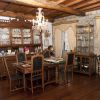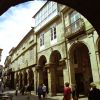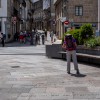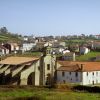- Accede I
- Regístrate I
- carrito
19. Casa de la Troya
19. Casa de la Troya
Galería de imágenes

El escritor madrileño Alejandro Pérez Lugín se trasladó en 1886 a Santiago para realizar sus estudios de Derecho. Tras trabajar como periodista para diversos periódicos, publicó en 1915 la novela ‘La Casa de la Troya’, en la que recuerda su vida de estudiante.
La verdadera Casa de la Troya, en la que se inspiró el autor de esta historia, no era más que una pensión de estudiantes, que luego pasó a ser propiedad de diversas familias hasta que en 1960 fue cerrada debido a su mal estado de conservación.
El 24 de marzo de 1966 el programa de radio ‘Ustedes son Formidables’ se propuso recaudar quinientas mil pesetas para adquirir la vieja hospedería de la Troya y rehabilitarla. En una hora y media de emisión ya habían recaudado el dinero. La casa se compra, pero la rehabilitación no es un hecho hasta los años noventa.
El Museo de la Casa de la Troya fue inaugurado el 27 de febrero en 1993, gracias al empeño de la Asociación de Antiguos Tunos de la ciudad. Se convierte así en una evocación de lo que fue una pensión de estudiantes de finales del siglo XIX y, por extensión, en reflejo nítido de las costumbres de la sociedad santiaguesa de ese tiempo, en la que el teatro, los bailes, las serenatas y los paseos por la Alameda animaban el día a día.
La visita de la casa permite recuperar una memoria que permanece suspendida en el tiempo y que se concreta en una colección de muebles, cuadros, fotografías y objetos que habrían pertenecido a las personas que inspiraron la novela. El edificio consta de un sótano, tres plantas y un ático. Las caballerizas fueron acondicionadas como pequeños salones de reuniones.
Adentrándonos en la pensión nos situamos en la “sala del respeto”, el lugar donde los jóvenes atendían las visitas de los familiares. El antiguo comedor está habilitado como lugar de estudio, y sobre todo como lugar de ensayo de la tuna compostelana. En el segundo piso se encuentran los dormitorios, uno colectivo y el otro individual, al cual se tenía derecho si se pagaba una peseta más.
Esta habitación era ocupada en la novela por el protagonista, Gerardo Roquer, joven natural de Madrid que llega a Santiago obligado por su padre para terminar sus estudios de Leyes. La tristeza de su exilio le dura poco, pues se cruza en su camino la señorita Carmiña Castro Retén, mujer de notable belleza y simpatía.
El amor juvenil, las aventuras y desventuras de los personajes convergen a lo largo de la obra hasta llegar a un final feliz con el casamiento de la pareja.



































